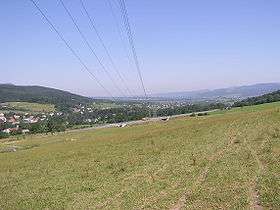Jablunkov Pass
Jablunkov Pass (Czech: ![]()
![]()
| Jablunkov Pass | |
|---|---|
 Jablunkov Pass seen from the southern slopes of Gírová (Girowa) mountain, looking northwest | |
| Elevation | 553 m (1,814 ft) |
| Traversed by | European route E75 |
| Location | Moravian-Silesian Region, Czech Republic |
| Range | Moravian-Silesian Beskids, Silesian Beskids |
| Coordinates | 49.51667°N 18.75°E |
It separates the Moravian-Silesian Beskids and the Silesian Beskids mountain ranges. It is one of the most important transport routes in the Western Carpathians. Road from Žilina to Těšín runs here. Košice-Bohumín railway line also runs here. It was an important route from the Middle Ages, connecting Upper Hungary with Silesia, more precisely Cieszyn Silesia.
Archaeological researches suggest it was an important route long before the Middle Ages. Travelling caravans were frequently attacked by bandits, so some fortifications were built in the place of today's Mosty u Jablunkova. Archaeologists presume they were built in the 13th century. Importance of this trade route grew over time and in 1529 in the fear of Turkish attack, new fortifications (pl: szańce, cs: šance) were built. It played an important role during the Thirty Years' War. After war it was renovated and new larger one were built nearby by Elżbieta Lukrecja, Duchess of Cieszyn. It eventually became a station with permanent garrison. Fortifications were last time renovated in 1808. It dilapidated from that time and locals picked up its parts as a construction material. Remains of this fortifications are today a popular tourist spot.
In October 1938 the whole Zaolzie area, including this mountain pass, was captured by Poland. On the night of 25-26 August 1939, the Jabłonków Incident occurred here, when a group of armed German Abwehr agents of the Brandenburg Regiment attacked the rail station in Mosty. The Jabłonków Incident has been named the first commando operation of the Second World War.[1]
The village of Mosty u Jablunkova lies in the pass.
Footnotes
- Canaris, by Michael Mueller, Geoffrey Brooks, page 136 ...who one year later would lead the first commando operation of the Second World War...
References
- Cicha, Irena; Jaworski, Kazimierz; Ondraszek, Bronisław; Stalmach, Barbara; Stalmach, Jan (2000). Olza od pramene po ujście. Český Těšín: Region Silesia. ISBN 80-238-6081-X.
- Kartografie Praha (2001). Velký atlas světa. Praha: Kartografie Praha. p. 23. ISBN 80-7011-514-9.